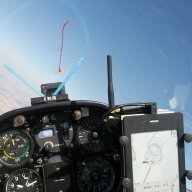-
Posts
911 -
Joined
-
Last visited
Content Type
Profiles
Forums
Gallery
Downloads
Blogs
Events
Store
Aircraft
Resources
Tutorials
Articles
Classifieds
Movies
Books
Community Map
Quizzes
Posts posted by Exadios
-
-
-
-
Good idea. Glider pilots have to demonstrate 2 or 3 spin recoveries per year in order to stay current. I recommend that all pilots practice their spins every year.If all else fails go to a gliding club and see if you can do some spin training in a glider. Most clubs have a glider that is capable of spinning and then you will know what a spin feels like. Having done spin training in a glider I feel that if I ever found myself in that situation in an ultralight (not that you should get that far anyway) I could confidently recover and have no further issue.One of the problems with the incipient spin training approach is that I can remember how disorientated I felt the first few times I spun an aircraft. Like anything else it takes practice to recover from a spin. The other problem is that it is possible to go from flying to spinning without going through any effective incipient spin. this is why gliders sometimes spin in a thermal.
-
 1
1
-
-
[media=vimeo]41754515[/media]
-
-
-
-
-
A report from the ATSB about a near miss between a power plane and a glider. Scroll down to p42 if necessary.
-
 2
2
-
-
Something that will problably filter through the GFA soon.
-
-
-
 2
2
-
-
Its a shame. From the video the landing oportunities look good where they crashed.
Apparently the glider, a Puchacz, got way out of position and there was a lot of slack in the rope before the weak link broke. The Puchacz then rolled over and dived into the ground.
-
-
-
Congratulations.Hi ExadiosMy Blanik L13A-1, VH-GPS, was back up in the air last Saturday. It was great to have her back up. I'm looking forward to many flights again this year and perhaps get the 300 kms done. I think this will be the third or fourth one back on line out of the original Llewlyn modified Blaniks.Cheers
Mike
-
Narrogin Gliding Club will be giving an Ab Initio course running from Friday, 2012/04/06 to Tuesday, 2012/04/10 inclusive. This corresponds to Easter. See the page for details.
-
Yes, boxing the slipstream - I forgot to mention that. That, and the "hookup" condition are the only times we are in high tow. And, as exercises, we only do them on calm days.Low tow, - high tow release -tug left- glider right, hopefully into lift... we used to teach an exercise called " boxing the tug" where a student/check would have to fly all four stations and quadrants accurately before we would solo them. all done at the appropriate height of course.Tug pilots earn their stripes, hell knows they don't earn much else...I'm seriously getting an itch to get back into it...

Even from low tow it is possible, on very rough days, to get out of position and go to high tow inadvertently - again a very dangerous situation - bung off!
-
We are a low tow club. I'm sure that all Australian tuggies are low tow supporters! :)The glider is directly in the tug's slipstream at this stage of proceedings and is responding to the wash. Just at the end before the bungs were pulled you can see the glider briefly going above the slipstream. Once tug and glider are both well clear of the ground, the glider will settle in either high or low tow (above or below the slipstream).
We release from low tow and use the speed for some height gain. The only time we go into high tow is in the event of a release failure at the glider end. The glider will move up to high tow to avoid the glider pilot having to occupy the cockpit along with 200' of rope, shackles and weak links (some pilots a fussy like that).When I was gliding we always travelled in low tow until shortly before release when we would go up through the slipstream to high tow and release. Tug and glider would break in opposite directions with the tug diving away while the glider attempted to remain in the thermal the tug pilot had hopefully found for it.
That's happened to me once. Very frightening! You have got to be quick - under 1 second - to release, otherwise its almost certianly a tug upset. I keep my hand on the release at all time when on tow.It's potentially very nasty if the tug breaks and dives before the glider has released because the resultant pressure on the TOST release can be so high that it becomes impossible to activate the mechanism. -
I think I meant LSAs.SLA's? -
Wow, 9 Blaniks with wings still attached! Who knew.

What the proceedure was in the event of an engine failure would have been I cannot guess.
-
-
-



Concordia
in Gliders and Soaring Aircraft Usergroup
Posted